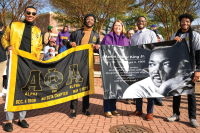There’s an app for that: If not, a growing number of students are learning to create one
 Imagine you’re a college student in the summer of 2010. One of your professors offers you a job. He has just acquired 30 of the newest android phones. Your assignment? Just fool around with them. See what they can do. Sweet.
Imagine you’re a college student in the summer of 2010. One of your professors offers you a job. He has just acquired 30 of the newest android phones. Your assignment? Just fool around with them. See what they can do. Sweet.
That’s what happened to Chris Blades the summer before his senior year at Western Carolina University.
SEE ALSO: At WCU, an app to keep students out of the rain
SEE ALSO: Student profiles
SEE ALSO: Coding for the rest of us
“I spent a large part of the summer just playing with the phone,” Blades remembers. “It was just about finding out what the phone could do, coming up with half-baked apps, seeing if I could make it work.”
The purpose of this exercise?
Related Items
Andrew Dalton, at the time a professor in WCU’s Computer Information Systems department, wanted to develop a course that would teach students how to design their own apps for smart phones. Blades was a promising computer science student. Between them, Dalton hoped, they could design a course that would give students the tools they needed to participate as designers, not just as users.
Now in its fourth year, the course has a steady stream of students coming through who are learning how to contribute to this warp-speed world.
In those four years, mobile apps have changed the way many of us live. Smart phones, with their handy size, their mobility and their GPS capability, have created a synthesis that has led to an explosion of possibilities. What started as a fun diversion — a calculator here, a restaurant finder there — has become a seemingly infinite landscape where users can enhance almost any aspect of their lives.
Dieters can enter any possible edible into their phones and find out not only how many calories it contains, but how many miles they’ll need to run to work it off. Investors can track their stocks. The Centers for Disease Control and Prevention offers an app to track epidemics. And then, of course, there are all those addictive games.
Many businesses now feel they need not only a web site but an app that suits it up for mobile devices. And for students in business or computer science programs, knowing how to design these mini-programs gives them an edge in the job market. Even if a prospective employer has no need of an app developer, it looks good on a resume if an applicant is conversant with the latest technology.
Another advantage: a new app is relatively easy to market. “There’s a really low barrier to entry in this marketplace,” Blades observes. “You can develop an app yourself, place it on Google Play Store for $25, publish as many apps as you want. It’s way more accessible for the end user, and much easier to develop. People know if they install, it will work. You almost don’t have to market it.”
WCU offers two approaches to app development. One, offered by the Computer Science department, deals with “native” apps: the kind that are offered at an app store and downloaded onto a mobile device. These require a different version for each platform: iPhone, Android or tablet.
A second approach teaches students to write mobile web apps, accessed through a mobile device’s internet connection rather than downloaded. They are essentially a mobile-friendly version of a web site, though they can still be stand-alone, without a web site. That’s what Clapper is teaching at the College of Business.
“A lot of companies are interested in this approach,” Clapper says. “If you use the native approach, you have to write different versions for the iPhone and Android. Mobile web apps are designed to work for the iPhone, the droid, and tablets as well. You don’t have to write separate versions.”
Fun though they are, the courses are not easy.
“These courses require the students to have an in-depth programming background in the Java programming language before the start of the course,” says Mark Holliday, a professor in the Department of Mathematics and Computer Science at WCU.
Blades now works in health care, and although he can see opportunities for using his app-building knowledge, it’s not his primary focus on the job.
“Health care is always a little slow to pick up on new technology,” he notes.
But he’s confident that the time will come. He’s already thinking about it.
“At a nursing station, for instance, some information comes in about a patient, maybe a change in their meds. If the nurse has just left the station, she misses it. If she has a mobile device, it dings when something comes in.”
Michael Bruce, a student at Southwestern Community College, is developing a mobile app for the Wheels Through Time Museum in Maggie Valley.
“It’s a huge difference, designing an app compared to a website for a desktop or laptop computer,” said Bruce, a Waynesville resident who’s designing the app for Apple products. “The physical makeup of the screen is so much smaller. That makes the design more complex. … You have to get the point across quickly and make sure users are able to access what they want very quickly.”
The possibilities, says Blades, are endless.
“Apps are going to be a bigger part of everything. Computers don’t move. The thing in your pocket can do the same thing, and it’s always in your pocket. I can’t imagine an industry in which faster, more immediate, more contextualized wouldn’t be more useful.”









